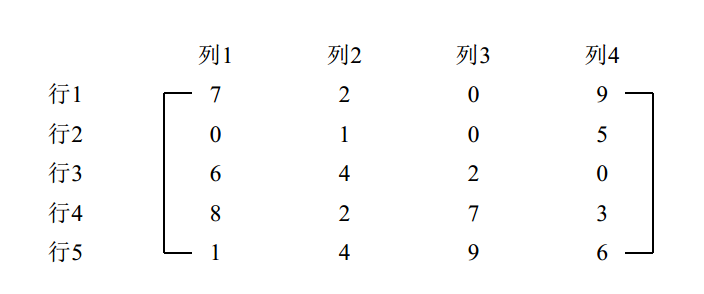数组和矩阵 2 - 矩阵
继续是《数据结构算法与应用:C++语言描述》,第四章数组和矩阵的笔记。本小节介绍矩阵的基本概念以及自定义一个类Matrix实现基本的矩阵操作。
矩阵
定义和操作
一个$m/times n$的矩阵(matrix)是一个m行、n列的表,如下图所示,其中m和n是矩阵的维数。

对于矩阵来说,最常见的操作就是矩阵转置、矩阵加和矩阵乘。
一个$m/times n$矩阵的转置矩阵是一个$n/times m$的矩阵$M^T$,它与$M$之间存在以下关系:
$$
M^T(i,j) = M(j,i)/quad 1/le i/le n,/; 1/le j/le m
$$
仅当两个矩阵的维数相同时,即具有相同的行数和列数,才可以对两个矩阵求和。两个$m/times n$矩阵$A和B$相加所得到的$m/times n$矩阵$C$如下:
$$
C(i,j) =A(i,j)+B(i,j)/quad 1/le i/le n,/; 1/le j/le m
$$
仅当一个$m/times n$矩阵$A$的列数与另一个$q/times p$矩阵$B$的行数相同,即 n=q ,才可以执行矩阵乘法$A B$。其得到的$m/times p$矩阵$C$满足以下关系:
$$
C(i,j) = /sum_{k=1}^nA(i,k)/ / B(k,j)/quad 1/le i/le m,/; 1/le j/le p
$$
矩阵加的代码实现如下
template<class T> void Add( T **a, T **b, T **c, int rows, int cols) { // 矩阵 a 和 b 相加得到矩阵 c . for (int i = 0; i < rows; i++) for (int j = 0; j < cols; j++) c[i][j] = a[i][j] + b[i][j]; }
矩阵转置代码实现如下:
template<class T> void Transpose(T **a, int rows) { // 对矩阵 a[0:rows-1][0:rows-1] 进行转置 for (int i = 0; i < rows; i++) for (int j = i+1; j < rows; j++) Swap(a[i][j], a[j][i]); }
矩阵乘法的代码实现如下:
template<class T> void Mult(T **a, T **b, T **c, int m, int n, int p) { // m x n 矩阵 a 与 n x p 矩阵 b相乘得到c for (int i = 0; i < m; i++) for (int j = 0; j < p; j++) { T sum = 0; for (int k = 0; k < n; k++) sum += a[i][k] * b[k][j]; c[i][j] = sum; } }
类Matrix
这里自定义一个类Matrix来实现矩阵的功能,在该类中,使用 () 来指定每个元素,并且各行和各列的索引值都是从1开始的。
其类定义如下:
#ifndef MATRIX_H_ #define MATRIX_H_ #include<iostream> using std::ostream; template<class T> class Matrix{ private: int rows, cols; // 元素数组 T *element; public: Matrix(int r = 0, int c = 0); // 复制构造函数 Matrix(const Matrix<T>& m); ~Matrix(){ delete[] element; } int Rows() const{ return rows; } int Columns() const{ return cols; } T& operator()(int i, int j)const; Matrix<T>& operator=(const Matrix<T>& m); Matrix<T> operator+() const; Matrix<T> operator+(const Matrix<T>& m)const; Matrix<T> operator-() const; Matrix<T> operator-(const Matrix<T>& m)const; Matrix<T> operator*(const Matrix<T>& m)const; Matrix<T>& operator+=(const T& m); void Output(ostream& out) const; }; #endif
构造函数,复制构造函数以及赋值运算符的代码如下:
template<class T> Matrix<T>::Matrix(int r, int c){ if (r < 0 || c < 0) throw BadInitializers(); if ((!r || !c) && (r || c)) throw BadInitializers(); rows = r; cols = c; element = new T[r*c]; } template<class T> Matrix<T>::Matrix(const Matrix<T>& m){ // 复制构造函数 rows = m.rows; cols = m.cols; element = new T[rows*cols]; int size = rows * cols; for (int i = 0; i < size; i++) element[i] = m.element[i]; } template<class T> Matrix<T>& Matrix<T>::operator=(const Matrix<T>& m){ // 重载赋值运算符= if (*this != &m){ rows = m.rows; cols = m.cols; delete[] element; element = new T[rows*cols]; int size = rows * cols; for (int i = 0; i < size; i++) element[i] = m.element[i]; } return *this; }
为了重载矩阵下标操作法(),使用了C++的函数操作符(),与数组的下标操作法[]不同的是,该操作符可以带任意数量的参数。对于一个矩阵来说,需要两个整数参数。如下所示
template<class T> T& Matrix<T>::operator()(int i, int j)const{ // 返回一个指向元素(i,j)的引用 if (i<1 || i>rows || j<1 || j>cols) throw OutOfBounds(); return element[(i - 1)*cols + j - 1]; }
二元减法的代码如下,矩阵加法操作符,一元减法操作符,增值操作符和输出操作符的代码都比较类似。
template<class T> Matrix<T> Matrix<T>::operator-(const Matrix<T>& m)const{ if (rows != m.rows || cols != m.cols) throw SizeMismatch(); Matrix<T> w(rows, cols); for (int i = 0; i < rows * cols; i++){ w.element[i] = element[i] - m.element[i]; } return w; }
矩阵乘法实现如下所示
template<class T> Matrix<T> Matrix<T>::operator*(const Matrix<T>& m)const{ // 矩阵乘法 返回w = (*this) * m if (cols != m.rows) throw SizeMismatch(); Matrix<T> w(rows, m.cols); int ct = 0, cm = 0, cw = 0; for (int i = 1; i <= rows; i++){ // 计算出结果的第i行 for (int j = 1; j <= m.cols; j++){ // 计算w(i,j)的第一项 T sum = element[ct] * m.element[cm]; // 累加其余项 for (int k = 2; k <= cols; k++){ // 指向*this第i行的下一个元素 ct++; // 指向m的第j列的下一项 cm += m.cols; sum += element[ct] * m.element[cm]; } // 保存w(i,j) w.element[cw++] = sum; // 重新调整至行首和下一列 ct -= cols - 1; cm = j; } // 重新调整至下一行的行首和第一列 ct += cols; cm = 0; } return w; }
更完整的例子可以查看我的 Github
复杂性
当T是一个内部数据类型时,矩阵构造函数复杂性是$O(1)$,当T是一个用户自定义类时,构造函数的复杂性是$O(rows cols)$,下标操作符的复杂性是$/theta(1)$,乘法操作符的复杂性是$O(rows cols*m.cols)$。











![[HBLOG]公众号](https://www.liuhaihua.cn/img/qrcode_gzh.jpg)

